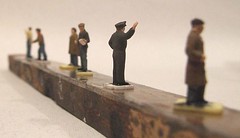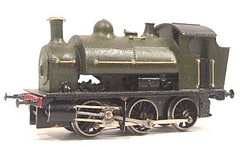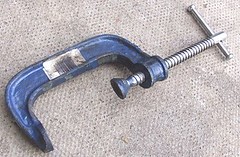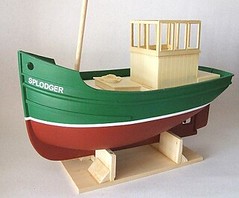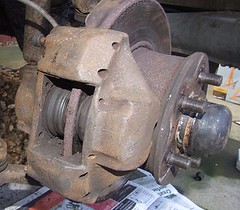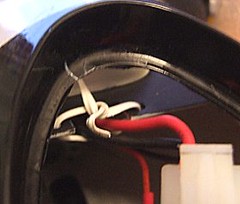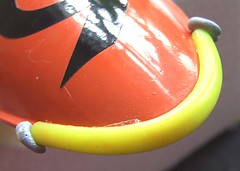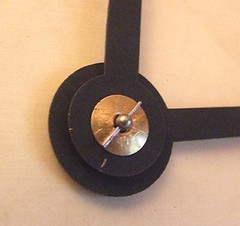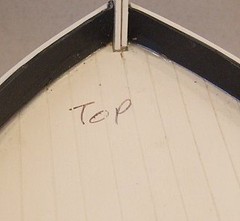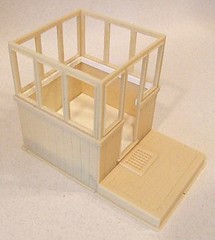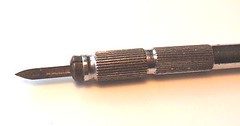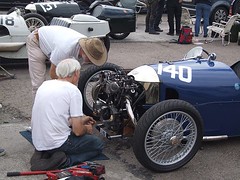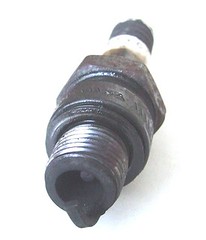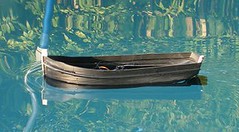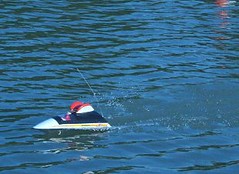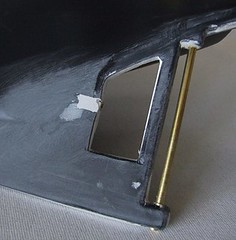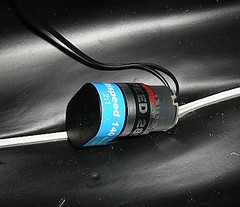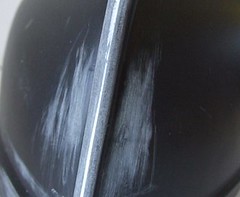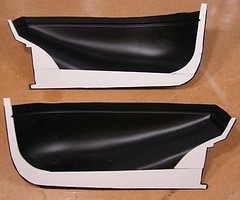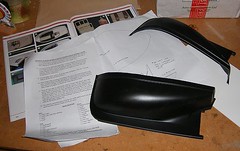Tough day at work yesterday. We were interviewing for a new assistant which meant a day sat in a warm room, wearing a jacket and concentrating on each candidates. By the end of it I returned home with a headache and more than a bit shattered. To be honest all I wanted to do by about 8pm was go to sleep.
That’s much too early to sleep so I fiddled around with a few things and ended up painting figures. After an hour and a half I had a nice set of people ready to pass on to my Dad to populate his newly constructed tugboat.
Engrossed in my task with only the radio for company time seemed to pass unnoticed. I completely forgot my tiredness and headache - total relaxation. It’s often said that the best way to deal with stress is to find something else to concentrate on to the exclusion of everything else. It looks like this works for mild headaches too. I really felt refreshed after my painting session.
In case you are wondering, the figures are stuck with double-sided tape to a bit of wood. This wood acts as support for things being painted and also as a pusher when I’m soldering. For an offcut, it’s a suprisingly useful tool !
A daily updated blog typed by someone with painty hands, oil under his fingernails and the smell of solder in his nostrils who likes making all sort of models and miniatures. And fixing things.
Friday, August 31, 2007
Wednesday, August 29, 2007
Flat pack chassis
According to “experts” you should always start your day with the worst job you have to do. After this then everything seems easier. Therefore, much as I might want to ponce around with the body of this model locomotive, I should get started on the difficult chassis.
This is no great hardship as I’ve always tended to build the mechanical bits first on the basis that the pretty bits are easy but if I can’t make something that works properly then there is little point in carrying on.
So, I took a photocopy of the plan from Railway Modeller and stuck it (with Bostick non-solvent glue) on two thinknesses of nickel silver sheet. Next I have to dig out the fretsaw table and cut along the lines.
This is no great hardship as I’ve always tended to build the mechanical bits first on the basis that the pretty bits are easy but if I can’t make something that works properly then there is little point in carrying on.
So, I took a photocopy of the plan from Railway Modeller and stuck it (with Bostick non-solvent glue) on two thinknesses of nickel silver sheet. Next I have to dig out the fretsaw table and cut along the lines.
Tuesday, August 28, 2007
GWR 1361 class
A few years ago I picked up this little beauty for 8 quid from a second hand stall at a show. At the time it seemed like a bargain. I also felt sorry for it as at that price it’s the sort of thing a kid could buy for their train set, yet it’s no runner and will take quite a bit of work to make it one. After discovering they had bought a pup, the loco would be heading for the bin. A shame as it’s a nice model built from a K’s whitemetal kit.
Since the loco is a dock shunter, it’s ideal for Melbridge Dock, and since that layout is booked into a show in a few weeks time, if I pull my finger out I might have it to run there.
Anyway, I started with research. A bit of work on the web uncovered this plan. Some questioning on the Double O Gauge Association message board brought the handy info that I could find a plan in the July 1970 issue of Railway Modeller. There is a bit more info in Wikipedia too.
My plan is to ditch the chassis and replace it with a scratchbuilt version. This will be a flexi-chassis as I’ve never built one in OO, only 3mm scale. I’ll try and re-use the cylinders and cross heads but the rest will have to go. K’s chassis were rudimentary at the best of times and this one has the wrong wheelbase.
The body will be stripped of paint. Handrails will be replaced with ones featuring smaller knobs. A bit of detailing, including a fake boiler bottom, and then a coat of BR Black paint.
OK, so it is a bit of a comedown to built a GWR model but I’m sure I can slum it for a while. Besides I need something to occupy me while the paint dries on the fishing boat.
Since the loco is a dock shunter, it’s ideal for Melbridge Dock, and since that layout is booked into a show in a few weeks time, if I pull my finger out I might have it to run there.
Anyway, I started with research. A bit of work on the web uncovered this plan. Some questioning on the Double O Gauge Association message board brought the handy info that I could find a plan in the July 1970 issue of Railway Modeller. There is a bit more info in Wikipedia too.
My plan is to ditch the chassis and replace it with a scratchbuilt version. This will be a flexi-chassis as I’ve never built one in OO, only 3mm scale. I’ll try and re-use the cylinders and cross heads but the rest will have to go. K’s chassis were rudimentary at the best of times and this one has the wrong wheelbase.
The body will be stripped of paint. Handrails will be replaced with ones featuring smaller knobs. A bit of detailing, including a fake boiler bottom, and then a coat of BR Black paint.
OK, so it is a bit of a comedown to built a GWR model but I’m sure I can slum it for a while. Besides I need something to occupy me while the paint dries on the fishing boat.
Monday, August 27, 2007
Clamped
After two days of soaking bolts in penetrating oil and then half an hour of bashing spanner, callipers and bolt heads – the brake calliper has been removed from my Type 2.
Initially I had planned to leave the brake line connected and just squeeze the pistons back in. As you can see from the state of this G-clamp, this didn’t work. Instead I twisted a cast metal clapm until it was completely useless. One piston has moved in about half its travel but the other doesn’t want to know.
So the campervan sits back on it’s wheels but with no brakes in the front drivers side. The calliper will go to the local VW specialist to be investigated and possibly replaced.
I suppose after all this hassle at least I know that there was a problem. I just hadn’t expected it to be a faulty calliper.
Initially I had planned to leave the brake line connected and just squeeze the pistons back in. As you can see from the state of this G-clamp, this didn’t work. Instead I twisted a cast metal clapm until it was completely useless. One piston has moved in about half its travel but the other doesn’t want to know.
So the campervan sits back on it’s wheels but with no brakes in the front drivers side. The calliper will go to the local VW specialist to be investigated and possibly replaced.
I suppose after all this hassle at least I know that there was a problem. I just hadn’t expected it to be a faulty calliper.
Sunday, August 26, 2007
Painted hull
The footie fishing boat’s looking really nice now. First the bottom was given a spray with red oxide colour car primer. This gives lovely rich red colour that I can’t get from hobby paints.
Next the water line was marked with pencil balanced on various boxes until it reached the right height. With the boat in its stand this was fairly painless although I had to guess the height from photos of other peoples models. I then masked this off intended to spray the top colour on.
My planned bright green hit a hitch when the pot of Humbrol enamel I intended to use was found to be nearly empty. Worse, the only shop easily accessible that sold the paint was shut for holidays.
Luckily down the same road was Castle Trains who stock Humbrol acrylics and Games workshop paint. I’ve heard good things about the later but never got around to trying some. Still, after a quick look at the rack of colours I found one I liked, amusingly named “Snot green”.
I’m not sure how to thin acrylic for spraying. Some suggest water will be OK, while others say you need some vile chemical compound that needs full bio-hazard suits to be worn in its presence. So I chickened out and brush painted.
The paint flows well with few bush marks. Two coats gave a good colour depth and hid the primer and test coat of enamel, something that acrylic paint normally balks at.
With the paint on, I added white lines from vinyl lining and named the boat after one of our cats using Bec letters.
Finally, and another first for me, I airbrushed on varnish from a DIY can. I used cheapo Blackstone varnish as found in every pound shop but that was just because all the Ronseal we had was gloss or matt and I wanted satin. The varnish was thinned with cellulose thinners but I suspect Humbrol ones would have worked as well. It took a few hours to dry properly so the cheap varnish probably wasn’t the best idea – or it had gone off a little while sitting in the garage in that pile of mostly finished paint cans we all own.
The varnish will help the stickers stay put, although this isn’t essential as they are supposed to be waterproof. The acrylic paint definitely needs protection though, as the stuff is notorious for rubbing off while handling – not sure if the Games Workshop paint is better in this respect as it’s intended for figures that will be handled. Best of all though, varnish brings some colours alive. The red is vibrant and even the green is improved.
Next the water line was marked with pencil balanced on various boxes until it reached the right height. With the boat in its stand this was fairly painless although I had to guess the height from photos of other peoples models. I then masked this off intended to spray the top colour on.
My planned bright green hit a hitch when the pot of Humbrol enamel I intended to use was found to be nearly empty. Worse, the only shop easily accessible that sold the paint was shut for holidays.
Luckily down the same road was Castle Trains who stock Humbrol acrylics and Games workshop paint. I’ve heard good things about the later but never got around to trying some. Still, after a quick look at the rack of colours I found one I liked, amusingly named “Snot green”.
I’m not sure how to thin acrylic for spraying. Some suggest water will be OK, while others say you need some vile chemical compound that needs full bio-hazard suits to be worn in its presence. So I chickened out and brush painted.
The paint flows well with few bush marks. Two coats gave a good colour depth and hid the primer and test coat of enamel, something that acrylic paint normally balks at.
With the paint on, I added white lines from vinyl lining and named the boat after one of our cats using Bec letters.
Finally, and another first for me, I airbrushed on varnish from a DIY can. I used cheapo Blackstone varnish as found in every pound shop but that was just because all the Ronseal we had was gloss or matt and I wanted satin. The varnish was thinned with cellulose thinners but I suspect Humbrol ones would have worked as well. It took a few hours to dry properly so the cheap varnish probably wasn’t the best idea – or it had gone off a little while sitting in the garage in that pile of mostly finished paint cans we all own.
The varnish will help the stickers stay put, although this isn’t essential as they are supposed to be waterproof. The acrylic paint definitely needs protection though, as the stuff is notorious for rubbing off while handling – not sure if the Games Workshop paint is better in this respect as it’s intended for figures that will be handled. Best of all though, varnish brings some colours alive. The red is vibrant and even the green is improved.
Saturday, August 25, 2007
Brakes
Fixing a squeaky brake is supposed to be an easy job. In essence you take the brake calliper to bits, clean the pads and pistons and put it back together. Total time just over an hour.
Taking the brake to bits was easy enough. The pads took a little levering to get them out but nothing major.
The problems started when I pushed the brake pedal to extend the pistons. These came out and we duly cleaned. All I had to do is lever them back into place and finish re-assembly. But they wouldn’t go in.
I levered and pushed. Bashing a screwdriver in worked a little but the best I’ve been able to get them in is about 5mm – not enough to put a pad in place. Even loosening the bleed screw to reduce the pressure doesn’t work.
So the next plan is to remove the calliper and get a G-clamp on the pistons to pull them back in. Of course the two bolts (19mm if you are contemplating the job) are seized so the van now stands broken again. And every few hours I soak the bolt heads in penetrating oil.
Taking the brake to bits was easy enough. The pads took a little levering to get them out but nothing major.
The problems started when I pushed the brake pedal to extend the pistons. These came out and we duly cleaned. All I had to do is lever them back into place and finish re-assembly. But they wouldn’t go in.
I levered and pushed. Bashing a screwdriver in worked a little but the best I’ve been able to get them in is about 5mm – not enough to put a pad in place. Even loosening the bleed screw to reduce the pressure doesn’t work.
So the next plan is to remove the calliper and get a G-clamp on the pistons to pull them back in. Of course the two bolts (19mm if you are contemplating the job) are seized so the van now stands broken again. And every few hours I soak the bolt heads in penetrating oil.
Friday, August 24, 2007
Battery
See this battery ?
Know what shape it is ?
Flat. Flat as a pancake that has been run over by a steamroller.
It’s one of three I own for larger boats. The other two are fully charged.
Of course when I grab a battery for last nights impromptu sailing, guess which one I picked up ?
Guess who’s going to be marking his batteries so he can tell them apart in future. And remember to test the model on the bench before it goes in the back of the car.
Know what shape it is ?
Flat. Flat as a pancake that has been run over by a steamroller.
It’s one of three I own for larger boats. The other two are fully charged.
Of course when I grab a battery for last nights impromptu sailing, guess which one I picked up ?
Guess who’s going to be marking his batteries so he can tell them apart in future. And remember to test the model on the bench before it goes in the back of the car.
Thursday, August 23, 2007
In flight repair
It’s a lovely evening so I fancy a sail. Running the batteries down in the Slingshot seems like a good idea and perhaps a gentle turn around the lake with Pigeon Pie.
First the Slingshot. Off it shoots across the lake and a couple of circuits are put in. Then on the far side of the water it makes a noise. The sort of horrible but undefinable noise that makes everyone who knows a bit about mechanical things think, “Something bad has happened.” with possibly a little added swearage.
The boat stopped dead in the water. Fortunately close enough to the bank that the handy long bamboo pole could just bring it in.
Looking inside the problem was obvious. The red wire that runs to the battery had wrapped itself around the coupling between motor and shaft. This is new – goody a fresh problem, I’d hate things to just work properly without adjustment after all…
OK, so I stick the wire out of the way using insulating tape. This lasts for about 4 laps and then the noise returns. On inspection the tape has worked as well as a chocolate teapot.
But my luck is in. When I removed the switch, this left the plate that includes the driver figure with a couple of holes. In the bottom of my boat toolbox there is some of that plastic coated wire normally used to seal sandwich bags. A couple of minutes with this and the wires are permanently pinned up out of danger.
I’ll need to tidy up a bit and perhaps add some black paint for looks, but it works a treat and the final battery is run down without incident.
First the Slingshot. Off it shoots across the lake and a couple of circuits are put in. Then on the far side of the water it makes a noise. The sort of horrible but undefinable noise that makes everyone who knows a bit about mechanical things think, “Something bad has happened.” with possibly a little added swearage.
The boat stopped dead in the water. Fortunately close enough to the bank that the handy long bamboo pole could just bring it in.
Looking inside the problem was obvious. The red wire that runs to the battery had wrapped itself around the coupling between motor and shaft. This is new – goody a fresh problem, I’d hate things to just work properly without adjustment after all…
OK, so I stick the wire out of the way using insulating tape. This lasts for about 4 laps and then the noise returns. On inspection the tape has worked as well as a chocolate teapot.
But my luck is in. When I removed the switch, this left the plate that includes the driver figure with a couple of holes. In the bottom of my boat toolbox there is some of that plastic coated wire normally used to seal sandwich bags. A couple of minutes with this and the wires are permanently pinned up out of danger.
I’ll need to tidy up a bit and perhaps add some black paint for looks, but it works a treat and the final battery is run down without incident.
Wednesday, August 22, 2007
Boat stand
This is just the best boat to make a stand for, ever. No messing around cutting curves for the hull, just put a slot in a couple of bits of wood and let the incredibly deep keel take the strain.
To be honest this job should have been done ages ago but you know how it is.
Anyway the next job is to start painting. After much digging around in Model Boats mags to see how other people had painted their boats, I’ve decided to go with a red oxide bottom and mid green top. The waterline will have to be marked, hence the need for a stand to hold the model level while I try and draw a line.
To be honest this job should have been done ages ago but you know how it is.
Anyway the next job is to start painting. After much digging around in Model Boats mags to see how other people had painted their boats, I’ve decided to go with a red oxide bottom and mid green top. The waterline will have to be marked, hence the need for a stand to hold the model level while I try and draw a line.
Monday, August 20, 2007
Petrol tank hits the magazine
More magazine success – this time my article on refurbishing my petrol tank is in Volkswagen Camper & Commercial.
And I’ve already spent most of the fee on books at the show last weekend !
Go on, treat yourself to a copy...
Sunday, August 19, 2007
Racing in the rain
Morning: Visit VeeDub show put on by the Vintage Volkswagen Society at Hatton. A quiet but friendly show. Not a huge number of vehicles attended but there were some goodies. I liked the shortened pickup – it’s for sale too, for £2500. If only the premium bonds had come up this month !
Anyway, for pictures, check my Flickr page.
Afternoon: Boat club BBQ with Slingshot racing. A good afternoon was had by all despite the weather. My boat was running well too. I won the final heat and would have clocked up 20 laps in five minutes had I gone the right side of every buoy and not been docked half a lap.
The Slingshots are gradually getting modified well beyond their RTR origins. The picture shows the bumper I have fitted to mine, which is made from a piece of fuel pipe slit along the centre and glued on with epoxy glue. The Blu-tack is holding it in place while the glue dries.
The bumper stops, or at least limits the damage I could cause to other boats in the hurly-burly of the racing. It hopefully stops me damaging myself if I clobber a buoy on the way round. If nothing else, it brightens up the already pretty loud colour scheme of the boat even more.
Anyway, for pictures, check my Flickr page.
Afternoon: Boat club BBQ with Slingshot racing. A good afternoon was had by all despite the weather. My boat was running well too. I won the final heat and would have clocked up 20 laps in five minutes had I gone the right side of every buoy and not been docked half a lap.
The Slingshots are gradually getting modified well beyond their RTR origins. The picture shows the bumper I have fitted to mine, which is made from a piece of fuel pipe slit along the centre and glued on with epoxy glue. The Blu-tack is holding it in place while the glue dries.
The bumper stops, or at least limits the damage I could cause to other boats in the hurly-burly of the racing. It hopefully stops me damaging myself if I clobber a buoy on the way round. If nothing else, it brightens up the already pretty loud colour scheme of the boat even more.
Saturday, August 18, 2007
Clock hands
A clock is a wonderful thing. Useful when working properly, nice to look at, and if it's a proper mechanical one, sounds nice. This means I own quite a few clocks and with my interests some of these were originally used on railways.
Ideally I would be able to maintain these myself. I tinker a bit but to be honest there has never been the time to learn the requisite skills. Fortunately there is a proper old-fashioned clock shop in Warwick where I can take things for repair if necessary.
A year or so ago I bought a clock from the local auction. It appears to be an LNER one and has the correct fusie mechanism. I say “appears to be” because the clock has been over-restored to remove any of the patina age gives the workaday item. Still, it didn’t cost toooo much.
It’s never kept good time though. I’ve had it nearly right but could never get things to my satisfaction – I’m really picky about these things. – so into the clock shop it went.
First time out things were improved but still not quite right. Back it went and there was a long wait for a part. Eventually this arrived and I got a call to say the clock was ready. Embarrassingly I didn’t have to pay anything toward the second repair – this is a real old fashioned shop where customer service is paramount.
Things didn’t seem quite right though still. The hour hand wasn’t moving properly when I got it home. Since all seemed fine when I had the office during the day so I concluded that something had shaken loose while I lugged it back on the bus.
Not wanting to take the clock back again I decided to have a quick look myself. The problem seemed to be that the gear attached to the hour hand wasn’t meshing. All those model railway gears have taught me a bit about gear mesh !
Getting at the gear was easier than expected although it did involve removing the mechanism with a 13mm spanner. Once exposed it was obvious that the position of an idler gear wasn’t quite right, something that was a matter of minutes work to adjust. Everything felt a lot tighter and the hands moved in sync, albeit at an increased rate since I’d taken the pendulum out.
While re-assembling things I took the chance to paint the hands. I’m sure these aren’t original as the minute one has a scribe mark on the back indicating that it’s been cut out by hand whereas I would expect a stamped out version on a clock of this age.
A quick coat of cellulose matt black did the job. Now everything is back together I just have to adjust it to keep good time. I hope.
Ideally I would be able to maintain these myself. I tinker a bit but to be honest there has never been the time to learn the requisite skills. Fortunately there is a proper old-fashioned clock shop in Warwick where I can take things for repair if necessary.
A year or so ago I bought a clock from the local auction. It appears to be an LNER one and has the correct fusie mechanism. I say “appears to be” because the clock has been over-restored to remove any of the patina age gives the workaday item. Still, it didn’t cost toooo much.
It’s never kept good time though. I’ve had it nearly right but could never get things to my satisfaction – I’m really picky about these things. – so into the clock shop it went.
First time out things were improved but still not quite right. Back it went and there was a long wait for a part. Eventually this arrived and I got a call to say the clock was ready. Embarrassingly I didn’t have to pay anything toward the second repair – this is a real old fashioned shop where customer service is paramount.
Things didn’t seem quite right though still. The hour hand wasn’t moving properly when I got it home. Since all seemed fine when I had the office during the day so I concluded that something had shaken loose while I lugged it back on the bus.
Not wanting to take the clock back again I decided to have a quick look myself. The problem seemed to be that the gear attached to the hour hand wasn’t meshing. All those model railway gears have taught me a bit about gear mesh !
Getting at the gear was easier than expected although it did involve removing the mechanism with a 13mm spanner. Once exposed it was obvious that the position of an idler gear wasn’t quite right, something that was a matter of minutes work to adjust. Everything felt a lot tighter and the hands moved in sync, albeit at an increased rate since I’d taken the pendulum out.
While re-assembling things I took the chance to paint the hands. I’m sure these aren’t original as the minute one has a scribe mark on the back indicating that it’s been cut out by hand whereas I would expect a stamped out version on a clock of this age.
A quick coat of cellulose matt black did the job. Now everything is back together I just have to adjust it to keep good time. I hope.
Friday, August 17, 2007
Midway Models
Fancying a day out, I caught the train, or to be precise 3 trains, to Leicester. My plan revolved around a trip to visit Midway Models. They advertise in Model Boats magazine every month in the Shop Guide section. I’ve always been a fan of model shops and make the effort to visit if I’m in town.
All I can say is that as a boat modeller this shop is worth making the effort for. It is absolutely superb.
One of the biggest problems I have faced as a (relatively) newbie boat modeller is finding the fittings to complete a vessel. You can get the kits but if you want some extra detail, then the search is on. Sometimes what you need is to see the bits in the flesh rather than just look at them in a catalogue or on a web site.
Well this shop has them in spades. It’s not big but then neither are the fittings. What it boasts is a huge range including loads that I’d never seen before.
Of course there are a good range of kits and I confess to being very tempted by several of them but left with a very reasonably priced bag of bits to adorn my models.
I will be back though. Leicester is an interesting city well worth a visit but for me this shop, 20 minutes stroll from the station, is the jewel.
Mail order is available, call: 0116 2701609 and if you do plan a visit a pre-emptive call is also advised in case the friendly owner is out at a show.
All I can say is that as a boat modeller this shop is worth making the effort for. It is absolutely superb.
One of the biggest problems I have faced as a (relatively) newbie boat modeller is finding the fittings to complete a vessel. You can get the kits but if you want some extra detail, then the search is on. Sometimes what you need is to see the bits in the flesh rather than just look at them in a catalogue or on a web site.
Well this shop has them in spades. It’s not big but then neither are the fittings. What it boasts is a huge range including loads that I’d never seen before.
Of course there are a good range of kits and I confess to being very tempted by several of them but left with a very reasonably priced bag of bits to adorn my models.
I will be back though. Leicester is an interesting city well worth a visit but for me this shop, 20 minutes stroll from the station, is the jewel.
Mail order is available, call: 0116 2701609 and if you do plan a visit a pre-emptive call is also advised in case the friendly owner is out at a show.
Thursday, August 16, 2007
Boat deck
There are a couple of sheets of plasticard in the boat kit, one for the hull strengtheners and the other for the hull. This is a big bit, which uses most a sheet. It’s a really odd shape too.
Fortunately George provides a template for the part which I duly cut out allowing a little extra to be on the safe side.
Because I like to be different I though a wooden deck would be a nice touch. Now I know I ought to use a bit of wood for this and discard the plastic as a new-fangled interloper, but this is a plastic boat with resin bits. And wood is a hassle to make waterproof. It won’t appreciate the shoving around required to seat the deck in the slot running around the hull.
So out came the Olfa plasticard cutter to put some groves in between decks – two passes seemed enough to give a good impression without going through. Then some coarse sandpaper added a grain effect. Looks nice to me.
And I took two goes to mark out the planks, hence the word “top” on the sheet. No point in following the old maxim “measure twice, cut one” if you cut along the wrong line…
Fortunately George provides a template for the part which I duly cut out allowing a little extra to be on the safe side.
Because I like to be different I though a wooden deck would be a nice touch. Now I know I ought to use a bit of wood for this and discard the plastic as a new-fangled interloper, but this is a plastic boat with resin bits. And wood is a hassle to make waterproof. It won’t appreciate the shoving around required to seat the deck in the slot running around the hull.
So out came the Olfa plasticard cutter to put some groves in between decks – two passes seemed enough to give a good impression without going through. Then some coarse sandpaper added a grain effect. Looks nice to me.
And I took two goes to mark out the planks, hence the word “top” on the sheet. No point in following the old maxim “measure twice, cut one” if you cut along the wrong line…
Wednesday, August 15, 2007
Wheelhouse
The fishing boat’s wheelhouse is made up of 5 very nice resin castings. I had to open out the windows by removing the vestigial coverings left from the mould and lightly clean the edges. Flatness was checked and some gentle finger tweaking sorted out any problems.
Superglue fixed everything together quickly and pretty solidly.
The last job was to add a plasticard floor. A couple of scraps of plastic glued on the bottom of the sides gave me some ledges to keep things level. This keeps the box square and adds strength.
Superglue fixed everything together quickly and pretty solidly.
The last job was to add a plasticard floor. A couple of scraps of plastic glued on the bottom of the sides gave me some ledges to keep things level. This keeps the box square and adds strength.
Do they think this is funny ?
OK, now I know Sainsbury’s hates me.
First they fill my petrol tank with water so the van won’t start. Then I spot that they use a cartoon of a Type 2 on their leaflets !
OK, so it’s a modern Brazilian water-cooled one, but it’s still a Type 2. This just isn’t fair.
First they fill my petrol tank with water so the van won’t start. Then I spot that they use a cartoon of a Type 2 on their leaflets !
OK, so it’s a modern Brazilian water-cooled one, but it’s still a Type 2. This just isn’t fair.
Tuesday, August 14, 2007
3 Sided Scraper
I was asked the other day, via the comments, what a 3-sided scraper is. I’ve mentioned it a few times and Iain Rice rattles on about one whenever he mentions soldering.
It’s an odd-ball tool that isn’t found in normal model shops or DIY stores. I’m not sure where it originates from, but I do know how you can get hold of one.
Contact Squires, 01243 842424 and ask for STS005, price 5.99. Page 292 in the catalogue if you want to look.
Not cheap for a metal scraper, but you never wear it out. In use the blade (which isn’t really sharp) is scraped sideways across the solder which is gradually carved away. Care is needed not to scratch the surface of brass but other than this, it’s a very useful addition to the toolbox.
It’s an odd-ball tool that isn’t found in normal model shops or DIY stores. I’m not sure where it originates from, but I do know how you can get hold of one.
Contact Squires, 01243 842424 and ask for STS005, price 5.99. Page 292 in the catalogue if you want to look.
Not cheap for a metal scraper, but you never wear it out. In use the blade (which isn’t really sharp) is scraped sideways across the solder which is gradually carved away. Care is needed not to scratch the surface of brass but other than this, it’s a very useful addition to the toolbox.
Monday, August 13, 2007
It never rains but it pours
So on Saturday morning I was cruising around at speed in my campervan. In the evening I head over to Kenilworth (about 7 miles) and pick up some petrol and a screwdriver from a supermarket garage on the way.
After a pleasant evening in the pub which could only have been improved by not having to drink Diet Coke, I return to the car park. Hopping in the van I turn the key. It turns over runs for a few seconds and then dies. I try it again and the engine turns over but won’t fire.
Several times.
I ring the RAC who tell me I have a 75-minute wait. As that means I’ll be in the car park until after midnight I decline. Instead I accept the offer of a lift home (Thanks Steve) deciding to return the next day when I’ll actually be able to see in the engine bay.
Handy hint: Don’t park front on under the only streetlight as this fills the engine bay at the back with deep shadow. Also, keep a working torch in the car not a stupid wind-up one.
I confess to not sleeping well that night. To be honest I find owning a broken car very stressful when I can’t seem to dig myself out of the pit of brokenness my van currently wallows in. Having reached the top edge earlier in the day and then crashed down was especially bad. A bit of me I’m not proud of hoped the local youth would be more successful than I was at starting and steal it.
Next morning things don’t look any better. The filter was full of fuel and a quick check with an old spark plug showed that there was plenty of spark. At this point the battery was complaining that it had done a lot of starting and not a lot of charging. I called the RAC again.
While I waited (about 25 minutes as it happens) I fiddled some more. The fuel bowl on the carburettor had petrol in it. If I sprayed carb cleaner in the top the engine would fire. Spraying this in the main jet achieved the same thing. I assumed that somewhere in the carb, petrol was not getting where it should.
When the RAC man arrived I explained what I’d done. He hooked the battery up to the bigger version in his van, did the carb cleaner trick again and it worked just as well for him.
Then we had another look in the carb bowl. I’d let the stuff run out the bottom and was more interested in trying to keep my hands clean. He looked at the outpouring and said,
“That isn’t petrol.”
Now I hadn’t thought of this. However not everything evaporated as quickly as petrol should. Some of it sat there. RAC man disconnected the filter and ran some off into a bowl. What you could see were definitely two liquids. Most was petrol but at the bottom were some large, clear globules.
Water.
After running off a bit more, everything was connected up. The engine fired and ran. A touch roughly to start with but enough to give me a good run home. In fact things improved as I drove. Later on in the day another quick trip was better still.
So the conclusion ? Water in the petrol. When I had filled up at (evil) Sainsburys earlier in the evening I think I got a fuel/water mix. This separated while I sat in the pub and the water gathered at the bottom, where the fuel outlet is. Then when I started the van I was trying to start on water.
I don’t have a picture of this so instead you get something from the vintage motor racing I went to see later that day. I can’t help feeling that a 3-wheeler Morgan race car with it’s JAP engine on the front must be a whole lot easier to work on sometimes. Pretty nippy on the track too !
After a pleasant evening in the pub which could only have been improved by not having to drink Diet Coke, I return to the car park. Hopping in the van I turn the key. It turns over runs for a few seconds and then dies. I try it again and the engine turns over but won’t fire.
Several times.
I ring the RAC who tell me I have a 75-minute wait. As that means I’ll be in the car park until after midnight I decline. Instead I accept the offer of a lift home (Thanks Steve) deciding to return the next day when I’ll actually be able to see in the engine bay.
Handy hint: Don’t park front on under the only streetlight as this fills the engine bay at the back with deep shadow. Also, keep a working torch in the car not a stupid wind-up one.
I confess to not sleeping well that night. To be honest I find owning a broken car very stressful when I can’t seem to dig myself out of the pit of brokenness my van currently wallows in. Having reached the top edge earlier in the day and then crashed down was especially bad. A bit of me I’m not proud of hoped the local youth would be more successful than I was at starting and steal it.
Next morning things don’t look any better. The filter was full of fuel and a quick check with an old spark plug showed that there was plenty of spark. At this point the battery was complaining that it had done a lot of starting and not a lot of charging. I called the RAC again.
While I waited (about 25 minutes as it happens) I fiddled some more. The fuel bowl on the carburettor had petrol in it. If I sprayed carb cleaner in the top the engine would fire. Spraying this in the main jet achieved the same thing. I assumed that somewhere in the carb, petrol was not getting where it should.
When the RAC man arrived I explained what I’d done. He hooked the battery up to the bigger version in his van, did the carb cleaner trick again and it worked just as well for him.
Then we had another look in the carb bowl. I’d let the stuff run out the bottom and was more interested in trying to keep my hands clean. He looked at the outpouring and said,
“That isn’t petrol.”
Now I hadn’t thought of this. However not everything evaporated as quickly as petrol should. Some of it sat there. RAC man disconnected the filter and ran some off into a bowl. What you could see were definitely two liquids. Most was petrol but at the bottom were some large, clear globules.
Water.
After running off a bit more, everything was connected up. The engine fired and ran. A touch roughly to start with but enough to give me a good run home. In fact things improved as I drove. Later on in the day another quick trip was better still.
So the conclusion ? Water in the petrol. When I had filled up at (evil) Sainsburys earlier in the evening I think I got a fuel/water mix. This separated while I sat in the pub and the water gathered at the bottom, where the fuel outlet is. Then when I started the van I was trying to start on water.
I don’t have a picture of this so instead you get something from the vintage motor racing I went to see later that day. I can’t help feeling that a 3-wheeler Morgan race car with it’s JAP engine on the front must be a whole lot easier to work on sometimes. Pretty nippy on the track too !
Saturday, August 11, 2007
More power to the Type 2 !
Last Wednesday I tried to go out in my Type 2 van. He’d worked fine a few days earlier but this time the engine fired and then died. Repeatedly. Thinking that maybe there was a problem with the pump I whipped the carb end of the fuel line off and cranked the engine. Petrol flew out of the end so that wasn’t the problem.
Reading my new indoor (i.e. not covered in grease and oil) copy of Haynes I reckoned that the problem probably lay with the ignition system. Well, I had fuel and air so it must be the spark that was missing. Knowing the HT lines weren’t in the best condition (I’d had a shock off them recently while tinkering) I took advantage of Just Kampers offer and bought a new Bosh Blue coil, spark plugs and leads set. Cost just over 30 quid plus postage.
Today I struggled to change the plugs. Whose crazy idea was it to put them there down those dark invisible holes ? Using a combination of the VW tool in the roll, a socket set plug wrench, a cranked version, perseverance and some bad language (why do the neighbours kids insist on watching when you really need to have a good rant ?) did the job with only a slightly skinned knuckle.
For an easy to work on van, this simple job is a pain in the backside. The trick is to find the tool that grips the plug and goes in the hole. Use this with fingers to start the thread and then finish with something that allows the final nip up. If the plugs were about 2cm longer this would be a much easier task as you could use finger tips to do the first stage.
Anyway, this is the plug from the offside front (under the air filter) cylinder. The spark gap is around a centimetre. All the others were fine. Where the hell did this electrode go ?
With new plugs, leads and coil the engine still wouldn’t fire. So remembering the fault we had after we replaced the fuse box, I cleaned and tightened the black wire to the + side of the coil. That fixed the engine. A little tickle of the mix and we had a good runner.
Now the moral of the story is that sometimes you get lucky. I doubt that many of the components really needed to be changed, the coil is being stored as a spare for example, but without doing all this work I wouldn’t have spotted this plug and replaced it.
On the road I have something I haven’t had for while. Power.
Cruising at 55-60mph along roads we previously struggled to 40 on was great. I suppose I’ve learned that you can run a VW on three cylinders but that fourth one doesn’t half make a difference !
Reading my new indoor (i.e. not covered in grease and oil) copy of Haynes I reckoned that the problem probably lay with the ignition system. Well, I had fuel and air so it must be the spark that was missing. Knowing the HT lines weren’t in the best condition (I’d had a shock off them recently while tinkering) I took advantage of Just Kampers offer and bought a new Bosh Blue coil, spark plugs and leads set. Cost just over 30 quid plus postage.
Today I struggled to change the plugs. Whose crazy idea was it to put them there down those dark invisible holes ? Using a combination of the VW tool in the roll, a socket set plug wrench, a cranked version, perseverance and some bad language (why do the neighbours kids insist on watching when you really need to have a good rant ?) did the job with only a slightly skinned knuckle.
For an easy to work on van, this simple job is a pain in the backside. The trick is to find the tool that grips the plug and goes in the hole. Use this with fingers to start the thread and then finish with something that allows the final nip up. If the plugs were about 2cm longer this would be a much easier task as you could use finger tips to do the first stage.
Anyway, this is the plug from the offside front (under the air filter) cylinder. The spark gap is around a centimetre. All the others were fine. Where the hell did this electrode go ?
With new plugs, leads and coil the engine still wouldn’t fire. So remembering the fault we had after we replaced the fuse box, I cleaned and tightened the black wire to the + side of the coil. That fixed the engine. A little tickle of the mix and we had a good runner.
Now the moral of the story is that sometimes you get lucky. I doubt that many of the components really needed to be changed, the coil is being stored as a spare for example, but without doing all this work I wouldn’t have spotted this plug and replaced it.
On the road I have something I haven’t had for while. Power.
Cruising at 55-60mph along roads we previously struggled to 40 on was great. I suppose I’ve learned that you can run a VW on three cylinders but that fourth one doesn’t half make a difference !
Friday, August 10, 2007
Fishing boat hull
We’re a bit out of sync with the picture here as this happened a few days ago. What you see is the first sailing of my model fishing boat. It’s not even got a deck yet but the weather was nice so it seemed a shame not to have a go.
Quite a bit of large lead shot (from an old divers weight belt) was poured in the bottom to get the hull something near the waterline. Without it there was a lot of cavitation from the prop.
With the weight in the bottom the hull romped around the water. It’s incredibly manoeuvrable to thanks the massive rudder. Top speed is untested as the bow wave threatened to come over the top of the bullwarks. A little less weight in the finished version I think !
Most importantly there weren’t any leaks so I can carry on with the nice building bits.
Quite a bit of large lead shot (from an old divers weight belt) was poured in the bottom to get the hull something near the waterline. Without it there was a lot of cavitation from the prop.
With the weight in the bottom the hull romped around the water. It’s incredibly manoeuvrable to thanks the massive rudder. Top speed is untested as the bow wave threatened to come over the top of the bullwarks. A little less weight in the finished version I think !
Most importantly there weren’t any leaks so I can carry on with the nice building bits.
Thursday, August 09, 2007
Slingshot racing
This isn’t my slingshot. There’s no way I’d put a couple of big ears on top even if they do help it to self-right after an accident. Good grief, the thing looks like it’s got Prince Charles stapled on it’s roof.
No, my boat is sleek and orange. And successful.
This evening was perfect for racing. The water was calm. The sky was clear and bright. It was even reasonably warm, although you’d hope that this last one would be a given in August even in Britain.
Anyway I missed the first heat but put in a couple of good runs in the next one and the final. My trick is to stay out of trouble and keep putting the laps in. Not breaking down helps too. In the end I won my first heat with 14.5 laps (in 4 minutes) and came second in the 5 minute final with 18.75 laps. I was only beaten by a single lap here and that I blame on the boat pulling to the left. I probably didn’t have the battery quite central in the hull.
OK, it’s not Formula 1 but then they probably don’t have the laugh we have either.
No, my boat is sleek and orange. And successful.
This evening was perfect for racing. The water was calm. The sky was clear and bright. It was even reasonably warm, although you’d hope that this last one would be a given in August even in Britain.
Anyway I missed the first heat but put in a couple of good runs in the next one and the final. My trick is to stay out of trouble and keep putting the laps in. Not breaking down helps too. In the end I won my first heat with 14.5 laps (in 4 minutes) and came second in the 5 minute final with 18.75 laps. I was only beaten by a single lap here and that I blame on the boat pulling to the left. I probably didn’t have the battery quite central in the hull.
OK, it’s not Formula 1 but then they probably don’t have the laugh we have either.
Tuesday, August 07, 2007
More holes
At the back of the boat there is a hole for the prop to rotate in. At least there is once you cut it out. The surface of one side of the hull is marked as a guide and measurements are shown the instructions.
I think I was supposed to cut this before glueing the hull halves together. How you are supposed to get the hole the same size and place on both sides if you do this is beyond me though. I just drilled a hole in each corner and cut the rest out with a piercing saw. Nice and quick and easy. After a bit or truing up with a file the end result looks neat.
You can also see the end of the prop shaft just poking out. I’ve already fillered it in place and smoothed this down with sandpaper.
Finally the brass rod is the rudder pivot. Fitting this is the toughest job so far. The top and bottom pivots have to be in-line or the rudder won’t swing. Drilling the bottom is easy enough but the top had to be drilled from inside at an angle. Waggling the bit made the hole big enough and the error was again made up with car body filler.
I think I was supposed to cut this before glueing the hull halves together. How you are supposed to get the hole the same size and place on both sides if you do this is beyond me though. I just drilled a hole in each corner and cut the rest out with a piercing saw. Nice and quick and easy. After a bit or truing up with a file the end result looks neat.
You can also see the end of the prop shaft just poking out. I’ve already fillered it in place and smoothed this down with sandpaper.
Finally the brass rod is the rudder pivot. Fitting this is the toughest job so far. The top and bottom pivots have to be in-line or the rudder won’t swing. Drilling the bottom is easy enough but the top had to be drilled from inside at an angle. Waggling the bit made the hole big enough and the error was again made up with car body filler.
Monday, August 06, 2007
Motor unit
For a change I’m using the recommended motor for this model. It’s a ready to use Graupner unit with a 2:1 gearing. All I had to do was drill a hole in the back of the hull, remove the propeller and fit it.
I’m not yet convinced because the prop shaft is a bit on the short side, it only just emerges at the wet end of the boat. Still, I don’t have to mess around with a coupling or anything like that so I suppose there are advantages.
I’m not yet convinced because the prop shaft is a bit on the short side, it only just emerges at the wet end of the boat. Still, I don’t have to mess around with a coupling or anything like that so I suppose there are advantages.
Sunday, August 05, 2007
Hull joint
I don’t like leaky boat. No-one does really, especially if they are full size ones, but in this case my ire is reserved for leaky model boats. With the real thing you can poke around in the hull and spot where the water is coming in. All you get on a model most of the time is a pool inside when you get it back from the lake. Then you have to spend an age trying to second guess the problem.
This quickly leads you to believe the pagans were right. Water is a spirit and it’s the spirit of mischief. The area with the hole will be dry – liquid gathering elsewhere to deceive you. How much fun is it fiddling around sealing joints that are good and ignoring the dodgy ones ? None at all thank for asking.
Anyway, sticking a couple of half hulls together seems like a recipe for disaster to me, a long joint most of which will be below the surface ? Good idea…
So having glued my hull, I’ve now filled the outside of the whole join with car body filler. This is smoothed down carefully and I hope will be invisible under the paint. Inside some nice runny epoxy glue has been stuffed everywhere my poking matchstick can find, hopefully to fill the voids and keep the water out.
Stay tuned boat modelling fans to see if this all makes a difference or if I’m building the worlds fist submarine trawler !
This quickly leads you to believe the pagans were right. Water is a spirit and it’s the spirit of mischief. The area with the hole will be dry – liquid gathering elsewhere to deceive you. How much fun is it fiddling around sealing joints that are good and ignoring the dodgy ones ? None at all thank for asking.
Anyway, sticking a couple of half hulls together seems like a recipe for disaster to me, a long joint most of which will be below the surface ? Good idea…
So having glued my hull, I’ve now filled the outside of the whole join with car body filler. This is smoothed down carefully and I hope will be invisible under the paint. Inside some nice runny epoxy glue has been stuffed everywhere my poking matchstick can find, hopefully to fill the voids and keep the water out.
Stay tuned boat modelling fans to see if this all makes a difference or if I’m building the worlds fist submarine trawler !
Friday, August 03, 2007
Hull sides
Stage 2 of the fishing boat kit involves cutting out some hull strengtheners (Stage 1 is cutting out the hull halves) and fixing these in the bottom of the hull.
These bits confused me as it wasn’t immediately obvious where they went. Luckily the picture in the review helped and it became clear that I was making a sort of jigsaw.
The instructions only seem to mention one set as well but I think that 2 sets are required. These are glued in using a proper big tube of plastic glue like I used to put plastic Spitfires together with. However, where this cause blobby joints and fogged canopies in the plane, here I need loads of glue that stays liquid until I can bring the parts together.
These bits confused me as it wasn’t immediately obvious where they went. Luckily the picture in the review helped and it became clear that I was making a sort of jigsaw.
The instructions only seem to mention one set as well but I think that 2 sets are required. These are glued in using a proper big tube of plastic glue like I used to put plastic Spitfires together with. However, where this cause blobby joints and fogged canopies in the plane, here I need loads of glue that stays liquid until I can bring the parts together.
Wednesday, August 01, 2007
Fishing Boat
Post 401 – Time for a new project.
From the “pending” cupboard comes the George Turner fishing boat kit that’s beeing living in there for several months. From the moment I saw this kit I knew I wanted to build it. At the time it wasn’t quite in production so I ended up with the boat that became “Little Miss Minty”. However as soon as I had the chance money changed hands.
This is a hugely popular kit. Loads of them have appeared at boat shows around the country – there is rarely a show report in Model Boats that doesn’t have a picture of one somewhere. Unfortunately this means that a review has already appeared in a mag so the only place you will see a write up of my version is on this blog.
The model itself is interesting. The thing it isn’t is a realistic model of a fishing boat. Instead it’s a caricature of one. This is probably what has made it so appealing to other modellers. The fact you can paint the model in pretty colours helps as well.
The kit itself consists of a vac-formed plastic hull and resin fittings. These are excellent and another reason the kit has been a success. Basic instructions are provided and I’ve supplemented these with the review in the magazine.
For a change I’ve even followed advice on the motorising unit to use, a ready built Graupner unit which looks a bit odd to me but I’ll give it a go.
From the “pending” cupboard comes the George Turner fishing boat kit that’s beeing living in there for several months. From the moment I saw this kit I knew I wanted to build it. At the time it wasn’t quite in production so I ended up with the boat that became “Little Miss Minty”. However as soon as I had the chance money changed hands.
This is a hugely popular kit. Loads of them have appeared at boat shows around the country – there is rarely a show report in Model Boats that doesn’t have a picture of one somewhere. Unfortunately this means that a review has already appeared in a mag so the only place you will see a write up of my version is on this blog.
The model itself is interesting. The thing it isn’t is a realistic model of a fishing boat. Instead it’s a caricature of one. This is probably what has made it so appealing to other modellers. The fact you can paint the model in pretty colours helps as well.
The kit itself consists of a vac-formed plastic hull and resin fittings. These are excellent and another reason the kit has been a success. Basic instructions are provided and I’ve supplemented these with the review in the magazine.
For a change I’ve even followed advice on the motorising unit to use, a ready built Graupner unit which looks a bit odd to me but I’ll give it a go.
Subscribe to:
Comments (Atom)
